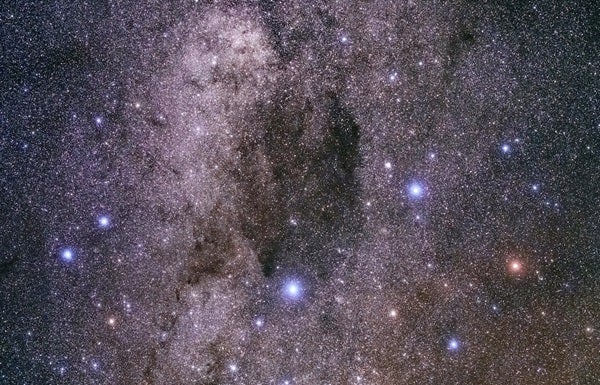The Coalsack Nebula is the most famous naked-eye dark nebula in the entire sky. Located in the Southern Hemisphere next to the Southern Cross, the shadowy nebulosity looks like a large void (5° by 7°) in the bright, flowing stream of the Milky Way. That’s more than large enough to fill most binocular fields.
While the majority of observers see the Coalsack as a uniform black patch, with careful scrutiny, some can detect intricate filamentary details within. For viewers to perceive these subtleties, the night must be free of both moonlight and earthly interference like light pollution and atmospheric dust.
The Coalsack was well known to early cultures. Inca legends tell how the creation god Ataguchu once became so enraged that he kicked the Milky Way, causing a portion of it to fly off and creating the Small Magellanic Cloud. The hole left behind was the Coalsack. Australian Aboriginal lore, meanwhile, refers to it as the head of an emu, even drawing a starless constellation of the lanky bird’s body that follows the form of the Milky Way’s stream northward.
However, we should refer to the Coalsack as the Dustsack, because that’s what it is: a gargantuan cloud of interstellar dust some 600 light-years away, making it the nearest substantial dark nebula to our solar system. Each grain of cosmic dust within is coated with an outer layer of water ice and simple organic molecules such as frozen carbon monoxide. The dust is so dense in regions that it blocks most of the visible light from stars behind the cloud. The bit of starlight that does seep through takes on a reddish tint. This effect, called interstellar reddening, occurs as the dust particles preferentially absorb and scatter blue light.
But like planetary nebulae, the Coalsack won’t last very long in cosmic terms. Fast-forward millions of years and this dusty void will have transformed into a display of newly sparkling stellar diamonds.
Make sure to explore Astronomy’s full list of 101 cosmic objects you must see. New entries will be added each week throughout 2022.
To get the latest astronomical news and observing content delivered directly to your door, subscribe to Astronomy magazine today!










